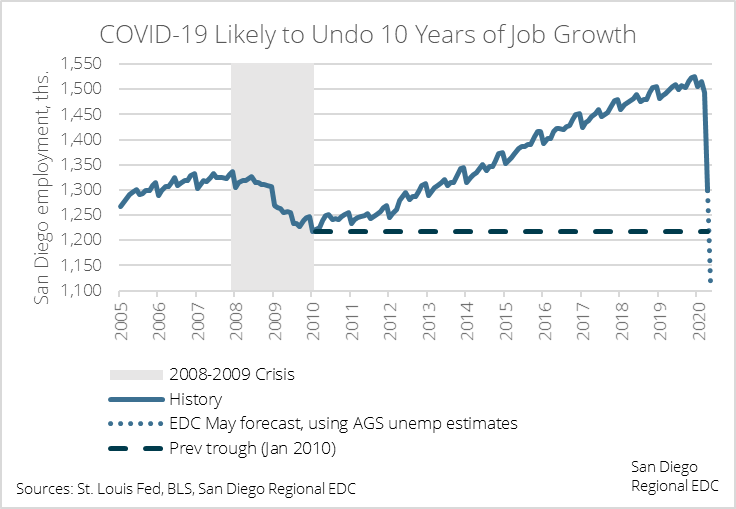We’ve seen and heard the unemployment numbers. But what does all of this really mean for our economic recovery in San Diego? Welcome to the ‘economy in crisis’ series – a bi-weekly breakdown of data at the national, state, and local level in the shadows of COVID-19.
10 YEARS OF JOB GROWTH LIKELY UNDONE IN 10 WEEKS
As expected, April’s jobs report was one for the record books. San Diego lost some 195,000 jobs, with especially steep cuts seen in accommodation & food services and retail as stay-at-home orders to curb the spread of COVID-19 essentially halted foot traffic to local restaurants, bars, music venues, and shops. Unemployment hit a historically high rate of 15 percent. March’s numbers were revised lower to reveal 10,400 fewer payroll jobs, bringing the total number of losses to 205,400 compared with the initial March estimates and roughly in line with our call for losses of about 230,000 jobs last month.
The April jobs report only measured employment as of the week of April 12, which means any additional job losses during the second half of April and first half of this month won’t be picked up until the May employment report due on June 19. Weekly unemployment estimates from Applied Geographic Solutions (AGS) indicate that unemployment in San Diego County may have been as high as 30.1 percent for the week ending May 9, with some zip codes in and around downtown potentially experiencing jobless rates of more than 40 percent. This is well above the U.S. estimate of 22.75 percent provided by AGS and implies that the May report could show an additional 10 to 15 percentage point climb in the unemployment rate from April.
Weekly retail sales estimates compiled by the San Diego Association of Governments (SANDAG) reveal a 43 percent reduction in receipts by San Diego retailers in April. Further, SANDAG anticipates a cumulative reduction in retail sales of more than 50 percent in May compared with pre-COVID sales levels—not an unreasonable assumption given the wide-ranging impact of stay-at home orders on retailers since March. If realized, the SANDAG retail sales forecast for May could mean another 70,000 to 75,000 job losses at retailers in the May employment report, even accounting for steady or growing receipts at supermarkets, bargain clubs, and drug stores. Taken together, if AGS’ unemployment estimates are accurate and SANDAG’s retail sales projections come to fruition, the May jobs report may reveal another round of record-breaking job losses similar to those reported for April.

LIGHT AT THE END OF THE TUNNEL
But there’s some good news: the worst has likely passed. With the City and County moving to gradually reopen the economy, businesses that have been able to hold on this long will likely be able to make it to the other side without having to initiate additional mass layoffs, at least not on the scale seen so far. The pace of initial jobless claims in California remains elevated but has slowed considerably. Now the focus will be on assessing continuing jobless claims, since those will indicate how many people have been able to get back to work.
The next great hurdle will be replacing lost jobs, especially for workers whose former employers were forced to shut down in the wake of the outbreak. This will require a balance between new businesses forming and targeted worker training programs to help connect people who are out of work with companies in higher-paying, more stable fields who are struggling to source employees. It could take several years before San Diego businesses lost during the COVID crisis are replaced, and worker retraining could get the workforce back on track much more quickly.
Of course, this would require public funding, which is scarce after several waves of fiscal stimulus. However, it would likely cost less to train employees and get them back into the workforce quickly than the amount of foregone income tax revenues, additional unemployment expenditures and longer-term government welfare programs that would be required as they wait for positions in their pre-COVID fields to open back up. Additionally, it is in the region’s best interest to get people back to work as quickly as possible, because job skills erode quickly as workers remain out of the workforce, which dramatically lowers their odds of ever re-entering the job market.
COVID-19 RECOVERY RESOURCES
As a partner of the local San Diego and Imperial Small Business Development Center, EDC is working directly with small businesses – free of charge – to counsel them on accessing COVID-19 recovery resources.
You also might like:
- Economy in crisis: April jobs reports likely to reveal record SD job losses
- Economy in crisis: unemployment claims at a record high, as SD looks to minimize virus’ spread
- Economy in crisis: SD job market rout continues, but opportunities emerge
- 3 resources for San Diego businesses – May 7, 2020